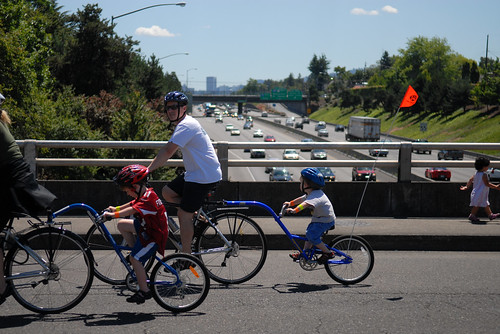
(Photo by J. Maus/BikePortland)
You’ve got to spend money to save money.
That’s the argument the Portland Business Alliance is likely to make when the Portland City Council hears from the public at 2 p.m. tomorrow about how much of the proposed Portland Street Fund should go to safety and how much to pavement maintenance.
City officials say $15 million spent on paving today would save about $50 million down the road, and they’re almost certainly right. Here’s what it looks like on a chart:
But wait — what about the other things we could be doing with some of that $15 million? Is the paving investment narrative so strong because it’s good policy or because it’s backed by powerful lobbyists?
What about, for example, creating a citywide network of protected arterial bike lanes, off-street paths and neighborhood greenways? Would that have any long-term effects on our economy and therefore the city’s budget?
Of course it would.
Though the city’s proposal is to dedicate only 8 percent of its hypothetical Street Fund revenue to bike-specific infrastructure, that’d be enough for the city to begin building a more modest variation on the 20-year bike plan it approved (but didn’t figure out how to pay for) in 2010. And it happens that in 2010, a Switzerland-based environmental epidemiologist took a close look at the likely effects of exactly that scenario: one in which Portland spends about $9 million a year (including state and federal grants) to improve its bike network enough to roughly triple the popularity of biking, to 15 percent of trips.
That’d mean our biking rate would rise to about the level of Davis, California; Bristol, U.K.; or Berlin, Germany.
The researcher, Thomas Götschi, drew on various other studies to estimate the amount of regional health care savings that would follow (in the form of lower premiums) and the amount of gasoline we would save (thus letting us spend more of our money on tastier, locally produced liquids).
Using those two factors alone, Götschi concluded that a “basic” but complete bikeway network, enough to get Portland to 15 percent biking, would return $58 million to the local economy for each $15 million spent. Here’s what that looks like on a chart:
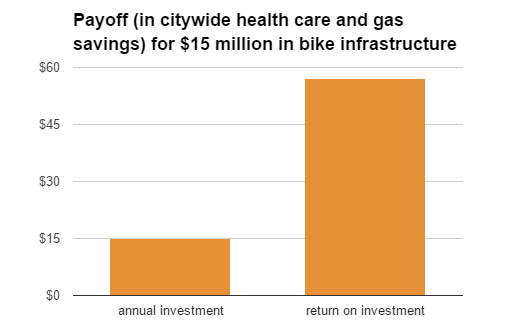
Now, here are the two return-on-investment projections together:
Well, that’s interesting.
Advertisement
But of course people are more than just the money they spend. The mere fact that people who are physically active are more likely to live longer has value in itself.
So Götschi also looked at a different way of calculating the benefits of biking. He added up all the additional days of life, throughout the entire city, that would result from the increased physical activity associated with better bike transportation. Then Götschi looked up the figure the U.S. Department of Transportation used to calculate the benefits of safer highways — $5.8 million per life saved, which is calculated from the amount of money Americans are willing to spend to improve their personal safety.
Using that economic value of $5.8 million per life saved, Götschi came up with a second “return on investment” figure that reflects, in a sense, the amount of additional human experience — hours worked, babies fed, lovers smooched, sculptures carved, the whole shebang — that a “basic” bike network would create.
It came out to $800 million per $15 million invested. Here’s what that looks like on a chart, compared to the $50 million payoff for road paving:
Should we take these figures seriously? Of course it’d be impossible to truly put a dollar value on the health and happiness that can come from biking. And just as surely, you can’t build a city budget out of health and happiness alone.
But here’s the thing about pavement maintenance: though no one seems to be disputing that it’s important and that some additional money for street paving would be well spent, the best-case outcome from repaving all our streets would be that Portland would stay exactly the same as it is today.
We could, in the name of “return on investment,” pour tens of millions of dollars every year into tackling all of our bad streets, then all of our mediocre ones, then all of our slightly degrading ones. That’s the strategy favored by the PBA and The Oregonian Editorial Board, who want you to believe that paving and maintenance is the Street Fund’s raison d’être (it’s not). But at the end of it all, the only thing we’d be buying is a guarantee that nothing about our city’s transportation system would change. No less gasoline would be burned. No jobs would become accessible to people without cars. No health care premiums would drop. And all those problems would continue to undermine our economy’s potential.
It’s hard to imagine that this is the investment strategy most Portlanders would choose.
Portland City Council will host a public hearing and first reading of their Street Fund proposal tomorrow (11/20) at 2:00 in Council Chambers.
*Publisher’s note: We are aware that PBOT’s “paving and maintenance” projects will very likely include elements (like re-striping and lane reconfigurations) that will be very beneficial to bicycling.

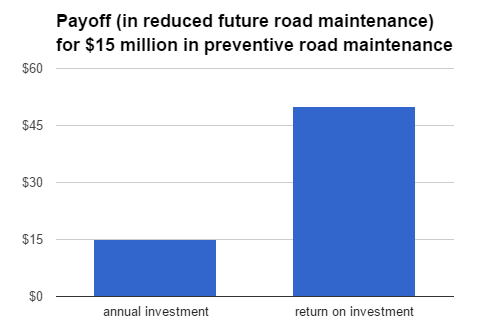
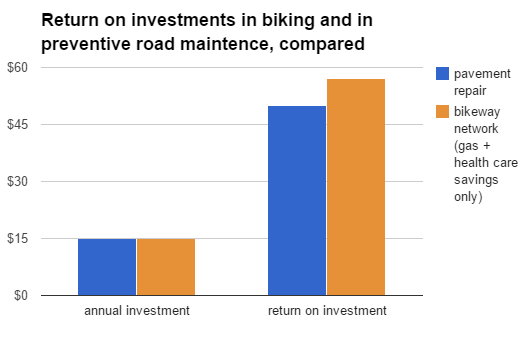
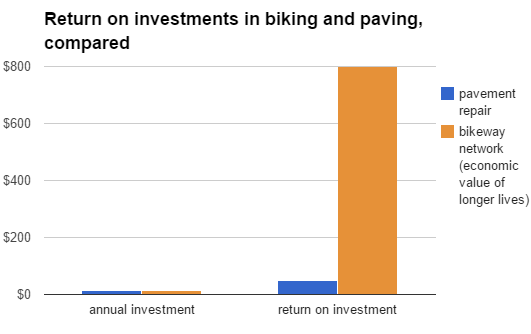

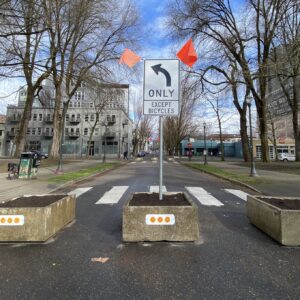
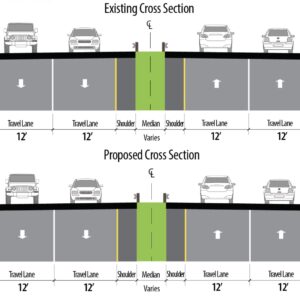

Thanks for reading.
BikePortland has served this community with independent community journalism since 2005. We rely on subscriptions from readers like you to survive. Your financial support is vital in keeping this valuable resource alive and well.
Please subscribe today to strengthen and expand our work.
I have had it with public employees who get to talk bike and environment and “green” and “social justice” but then do all the same crap that keeps us under the foot of the petroleum industry.
I hereby propose that city officials who don’t really want to do anything to improve the safety and equity of our streets should not be allowed to say any public statements that make it look like they care about safety and equity.
I hate being the bearer of bad news, but:
Note that although the benefits of building bikeways are mostly societal benefits, while the benefits of paving are directly affecting future Bureau of Transportation budgets.
So I would ask the question: if I can
(a) spend $1 to save myself $3 (net savings $2) in the future or
(b) spend $1 to save myself $.25 (net cost $.75) and save society $10 – Paving directly helps my future budget while bikeways helps my future budget much less and helps other folks’ bottom lines quite a bit.
Individuals would often take choice (a), government is often asked to take choice (b) and we wonder why governments are broke all the time.
I think a sensible person would do some combination of a and b just like the City is proposing
Good analysis.
Funny you say this, but the average income in Portland is around 45k a year. Lifetime earning potential of 1.8 million dollars. If the automobile was eliminated from your budget, you’d save roughly 400k over your life time. Which puts you 800 k over your car driving friends – if you do nothing else but ride the bike..
If you invested the money that would normally go towards automobile expenses every month and got a 4% average interest rate (Many AAA bonds give you this much, it could be much more money if you invested it more aggressively), you’d have almost another million dollars added to your lifetime earnings.
Sorry I’d get more specific, but I’ve done this same post about a dozen times (I should just make a cut/paste doc. on it). All the numbers are based on AAA yearly automobile cost estimates -not perfect I know but it’s a base, and the automobile costs are assumed to remain the same for 40 years which doesn’t happen (it goes up every year and will probably top 10k this year).
And yes I’m aware there are ways to make driving less expensive, the first being never ever buying a new car and avoiding financing the purchase.
I ran these numbers as my son was turning 15 about a year ago to show him how what seems to be relatively small decisions like driving can have on your long term well being. Needless to say he seemed pretty shocked that driving for him is potentially a million dollar decision, and now nearly a year later and he’s yet to show any interest in a trip to the DMV.
You’ll have some level of transportation expenses though, whether that is a bus pass, bike maintenance/parts, carshare, etc.
But your point is a fair one.
You’ll also have to potentially factor in that you will be somewhat limited in where you will likely live (and that could mean more expensive housing in a place like Portland).
Related concepts:
http://www.cityclock.org/billion-economy-car-free/
Interesting. I had to read what you wrote three times. Maybe I’m dense, but I’m having trouble making sense of this.
“Note that although the benefits of building bikeways are mostly societal benefits, while the benefits of paving are directly affecting future Bureau of Transportation budgets.”
I thought you were going to write the (b>costs of paving are directly affecting future Bureau of Transportation budgets
Because as you wrote it I don’t understand the italicized clause. The benefits of paving, presumably, are to make driving faster, easier, more fun, and as Michael wrote above, further cement the status quo. How is this a benefit to PBOT’s budget? Per Todd Litman, every mile driven is a net cost to the government (more expenses than are taken in from fees and taxes that are used to pay for transport infrastructure), while every mile biked is a win for the government (fewer expenses than are taken in from fees and taxes).
Oh! I think I just got it. You are thinking ‘paving is preventative maintenance that will help us avoid even greater expenditures down the road,’ as is shown in that first graph. Hm. I guess I’d say that is 20th Century logic. In the 20th Century we figured the future would be an extrapolation of the past. VMT would rise every year. The Dow Jones would keep rising. More people would have children this year than last. Etc. But when it comes to second guessing future road maintenance obligations, I think the first graph in Michael’s article is woefully out of date & out of step with our future priorities and constraints.
Assuming we will always have asphalt, and cars and trucks to wear it out, is not the best we can do. PBOT needs to instead be calculating how to wean themselves/us all off the gooey black stuff ASAP. Focusing on preventive paving is like that exhortation to take extra junk out of our car trunks and making sure our tires have the right air pressure as ways to ‘save’ gas. Both are obsolete ways of framing the problem, of comparing risks: by focusing on these peripheral dimensions they obscure that the real question is how to move beyond the automobile. Someone at PBOT sooner or later is going to stop pretending the looming end-of-free-atmosphere and end-of-cheap-oil don’t concern us.
“So I would ask the question: if I can
(a) spend $1 to save myself $3 (net savings $2) in the future or
(b) spend $1 to save myself $.25 (net cost $.75) and save society $10 – Paving directly helps my future budget while bikeways helps my future budget much less and helps other folks’ bottom lines quite a bit.”
Here’s my suggested re-write:
So I would ask the question: if I can
(a) spend $1 on a bike to save myself $100 on a car (net savings $99), or
(b) spend $15M/yr on a fruitless quest to stave off the end of automobility, which as a whole is costing society billions annually, and will cost trillions once we realize belatedly that it is over…
– Paving is the last place I’d spend taxpayer’s money since bikeways yield dozens of returns that are not subject to the stranded assets problem that adhere to cars-only infrastructure, or infrastructure that while it may be useful to others is nevertheless built to standards vastly exceeding what human powered transport requires.
Hey, Merkley’s on board!
http://www.oregonlive.com/mapes/index.ssf/2014/11/jeff_merkley_says_45ths_of_fos.html
“Wise stewardship means we must leave four-fifths of the conventional fossil fuels in the ground,” said Merkley.
PBOT, get with it!
One strategy is to find out whether a business you frequent is a member of the Portland Business Alliance. If they are, drop the business an email and let them know how you feel about the Portland Business Alliance stance. You can find out who’s a member by searching their directory at http://weblink.portlandalliance.com/directory/directorystartpage.aspx (they also have a form you can click-through after searching to send an email to that member).
Very helpful. I tried to find out this information when PBA asked for 75% for paving. Thanks.
I joined the PBA b/c I think bikes are good for business. It will take a lot more of us to join and show up at meetings before their official policy stance reflects the view that bikes are good for business.
I would love to see our biking rates jump to Berlin-levels.
This is good, data driven journalism.
Keep stories like this coming.
Fantastic piece! Hats of to you Michael—and to that Götschi fellow. 🙂
If livability is a shared goal then it’s important to frame the analysis as benefitting all of us.
Take an example of a set of bike lanes totalling 20 million $
Anything that favors a single group (in this case, cyclists) over another creates opportunity for criticism.
Meanwhile, the same 20 million spent on the exact same bike lanes where it is characterized as reduction of automobile traffic such that the typical motorist *gains* from it, then it can be viewed as a positive for everyone.
Instead we allow media outlets who just want to make a dollar with sensationalism and polarization frame the question in an “us versus them” mentality.
What we need is an articulate person of political power with enough backbone to say these things and stand by it while some media outlet tries to paint it as something frivolous. Where is such a person or people? I’d like to vote for them.
You just did. I’ll vote for you.
The problem isn’t paving; it’s the streetcar. Portland already neglected infrastructure to spend $176 million on 7.35 miles of track and PBOT is spending $4.4 million every year on streetcar operations. Five times as many Portlanders bike downtown as use the streetcar, but there’s very little money left for bikes. And they want to build more streetcar track, hence the new tax.
I wouldn’t conflate all of these. While I think they are woefully underspending in streetcar projects on ways to protect people on bikes, the money spent on streetcar capital projects, on streetcar operations and on PBOT projects to help bikes are different dollars.
Here’s a breakdown I found showing where the capital and operating costs come from. In most cases, those dollars wouldn’t be available unless the streetcar were constructed: http://www.portlandstreetcar.org/pdf/capital_and_operations_summary_FY2014.pdf
Portland got a $75 million grant from the feds in return for spending $176 million on the streetcar and spending $8 million every year for streetcar operations.
Minneapolis got a $25 million grant from the feds with which it built 75 miles of bike lanes and trails, created a bike sharing system and a bike library where low income residents can borrow bikes for six months.
Here’s the PBOT budget for General Transportation Revenues (unrestricted) for 2013/14:
$893,000 for “Active Transportation” (includes bikes)
$3,807,700 for streetcar operations and maintenance
https://www.portlandoregon.gov/transportation/article/466159
Requested GTR budget for 2014/15:
$806,200 for “Active Transportation”
$3,921,931 for streetcar operations and maintenance
https://www.portlandoregon.gov/transportation/article/478892
It’s not about money. It’s about priorities. Very few of the promises made to the bike community are actually written into the new tax ordinance.
From Governing 2012:
“Another project known as “closing the loop” — connecting the new streetcar line to the new light rail line — only has about half of its funding nailed down, though officials have a few years to figure out that one. “We’re looking under every seat cushion and rock to find spare change,” Smith says. New revenue sources may be necessary. One idea that’s been pitched is a local gas tax. Another is something called a street utility fee, which would be something like a property tax. ”
http://www.governing.com/topics/transportation-infrastructure/gov-portland-oregon-struggles-to-remain-leader-in-public-transit.html
Wow. Thanks for that. Makes you wonder.
Wait – did Götschi study the reduction in car trips and the reduced wear on the city streets???? I missed that bit….
No, he didn’t.
Worth noting, though, that on streets that are in decent condition more of the wear and tear is probably from heavy freight and buses than from personal cars.
People shouldn’t need bar graphs and statistics to understand that major highways and arterials are filled to capacity, almost exclusively with motor vehicles during commute hours, and daytime hours between.
Better community design and bike infrastructure supporting it could conceivably make some of the transportation budget go further, if a greater number really would use it get around by bike instead of motor vehicle.
Whether they would or not, in Washington, Clackamas and Multnomah counties, is the big dollar question. Building, for example, a lot of nice cycle tracks without much of an increase in overall road use on them by people biking, wouldn’t speak well for active transportation investment.
Most folks do not want to bike when the weather is nice, much less when it’s cold and wet. People want the convenience of their cars. I do not think there will be a big shift to bikes or public transportation until they are forced to use those modes. It will happen – oil will become unaffordable eventually. At first that will cause lots of carpooling and that will be good for congestion – and later as the price of oil goes higher people will bike or use buses/light rail, etc.
Right now if it came down to a vote for money for paving or for bike infrastructure, paving would get 90%, bikes would get 10%.
“Most folks do not want to bike when the weather is nice, much less when it’s cold and wet. People want the convenience of their cars.”
I disagree. You are neglecting the fact that for over a century our system has been rigged in favor of automobiles, of making the way smooth and wide for them to the exclusion of all other modes. To swoop into that sort of situation and claim as you just did that this is a Panglossian world, a situation where everyone was free to choose their mode, is foolish. Cars can be convenient, but so can a bicycle. Mostly it depends on what you are used to. I know dozens of people who got rid of their cars, stopped driving, and wouldn’t go back. Are their experiences so inconceivable for countless others? I don’t think so. A lot of people drive because they (feel they) have no choice. In many cases they may be right, to a point.
“You are neglecting the fact that for over a century our system has been rigged in favor of automobiles, of making the way smooth and wide for them to the exclusion of all other modes”
The poster isn’t neglecting anything. What you state is a fact and a major part of our reality. We don’t just get to hit the reset button and pretend like it didn’t happen. Like it or not (fair or not) it does and will MAJORLY affect peoples’ choices and opinions.
There’s a very large spread of possibilities between
(a) most folks don’t want to bike, prefer the car, and
(b)We don’t just get to hit the reset button and pretend like it didn’t happen.
Trek 3900 was arguing that people’s mode choice reflects their preferences, what they want. I’m arguing that we can’t conclude much about what they want from their mode choice because that choice isn’t for many the kind of choice we mean when we use that word. I wasn’t saying anything about pretending it didn’t happen, I was suggesting that when making pronouncements about what people want it is necessary to keep in mind how we got here; & by implication, that by pursuing a course of resetting this imbalance going forward we could very well see more uptake of biking (=more people wanting to bike, even in the rain) than Trek 3900’s comment would allow. Preferences are neither static nor unfettered.
“It came out to $800 million per $15 million invested. Here’s what that looks like on a chart, compared to the $50 million payoff for road paving.”
A great way of looking at this, but as Patty hinted above, just one of many, all of which (I think) point in the same direction: bikes are a much better investment than cars. And if you start tallying the positive feedback loops from taking this tack, there’s really no practical upper limit to the benefits. Not the least of which is that as automobility wanes, the need for separate infrastructure for bikes (the cost we’re talking about here) eventually disappears altogethe. We can have Sunday Parkways every day of the year on any road we’d like, and no barricades (another cost saved) or sponsorship needed!
I wish it was in the plan for the street fee/tax/whatever to have a checkbox where I could add an additional $5/month to go towards bicycling infrastructure.
Quote: “…Trek 3900 was arguing that people’s mode choice reflects their preferences, what they want. I’m arguing that we can’t conclude much about what they want from their mode choice because that choice isn’t for many the kind of choice we mean when we use that word…”
It is true that if you make ALL streets in the metro area safe for bikes, more people will ride bikes. My wild guess is that if gasoline stays at the current price you might get 2x or 3x as many riders as you have now. BUT most will choose the comfort of their cars – people LOVE driving. I love a good bike ride but I love to drive a car too. AND when I bust my hiney for 15 miles in the cold to get to work, I question the health benefits of riding on bike lanes only 3 feet from the exhaust pipes of motor vehicles.
I’m delighted we agree on so much, Trek 3900.
I think the thing that is forgotten by the Social Utopians is the fact the your avenge pubic worker is going to get paid by the hour no mater what, if its fixing a street or a bike path and that its going to be hard to lay them off as they are in a union and politicians don’t like to go up against the unions. Being that said we shouldn’t use Europeans models as example and they tend to live in apartment and American like individual houses and is been pointed out in Jeff Mapes “Pedaling Revolution” and Pete Jordan “In The City of Bikes” that most bicycle trips or short range single persons and that you still have persons commuting from out side of the city and in Europe they have and excellent rail and buss transportation system. The other thing to remember is you need to transport goods and services in and round the city such as your new bike, along with persons who can not physically use a bike or a trike. There is always been a necessarily evil in having roads going back to the Roman times. So the bottom line is if you had a city that only uses bicycle and tricycle to get around you wouldn’t need a sophisticated infrastructure as we have today, a trail of packed gravel would suffice.
Michael, you run the risk of comparing apples and oranges unless we are more specific about what is meant by roadway maintenance. There is a safety cost to allowing a road to degrade, as well as a cost to the public.
An example. A cyclist in Hawaii (some years back) was injured severely when he hit an unrepaired pavement ridge and lost control of his bike. He sued the State of Hawaii for a six or seven figure amount and that turned out to be a very, very expensive pavement ridge. Likewise, a car losing control after hitting a pothole is a hazard. A cheap fix down my way is to use asphalt liquid to patch cracks. These are deadly to motorcyclists (I own a motorbike, too). Partial shoulder paving is dangerous to cyclists.
One has to accept that as long as the public is driving cars, the government is responsible for making sure the streets are not minefields of uncorrected wear and tear–that makes our lives more dangerous too. That should not detract from building decent bike infrastructure. We need both.
All the best,
K
Good points.
That is a very poor example of lawsuits over the years that has been invented out of whole cloth. As an example there was a farmer who had a new ladder and place in on a frozen manure to work on the side of his barn to do some work. A few week later he went back out to the same spot and set up his ladder the only thing was weather was warmer and the ladder moved in the manure pile causing the farmer to fall off and sprang his ankle. He then sue the ladder company and won! Why. Because the ladder company didn’t have a sticker warning that the ladder might move in a warm manure pile. So the bottom line is we have become a sue happy nation and I hope you will notice how many doctors have given up there private practices. Next time you are in a hardware story notice how many warning sticker or on a extension cord. As far a the bikee who was hurt in Hawaii, how many times did he/she go by the spot before getting hurt. BTW which do you like Apple juice or Orange juice.
Here is a joke for you. Why dose New Jersey have all the toxic waste dumps and California have all the lawyers. Answer New Jersey had first chose.
Well, it was an actual lawsuit. I knew about it because my brother in law used to work in the State Attorney General’s Office and worked on the case.
Also, you and Michael might want to read attorney Steve Magas post here:
http://www.ohiobikelawyer.com/bike-law-101/2014/07/whats-a-pothole-worth-to-the-city-about-a-million-bucks/
As far as snide remarks, feel free to leave all you want, but at least learn to spell. That’s “does”, not “dose”.
As a dyslectic who has been climbing brick wall all my life, that is understandable the spelling typo, however I do stand by my statement as I have been following in the Modesto Bee, a shyster lawyer as he and his accomplices are using Americans with Disabilities Act as a shakedown scam of the local businesses and putting some of the them out of business.
http://www.modbee.com/incoming/article3170982.html
http://www.des.ucdavis.edu/faculty/handy/Davis_bike_history.pdf
Fifty years of bicycle policy in Davis, CA Ted Buehler Institute
http://www.des.ucdavis.edu/faculty/handy/Davis_bike_history.pdf
by T Buehler – Cited by 40 – Related articles
Fifty years of bicycle policy in Davis, CA. Ted Buehler. Institute of Transportation Studies. University of California Davis. Davis, CA 95616. Phone: 530-848-3615.
I thought that’s what our gas tax, tags and DEQ expenses were suppose to pay for; the upkeep of our lanes we drive in? Are you paying for the lanes you ride in or bike bridges that are built? I’m a home owner am I paying for that and the upkeep of bike lanes? I choose to drive, as I choose to spend time with my family rather than commuting that’s more important to me. Its everyone’s personal choice; some things are more important than money. Just make sure your giving and not taking. One more thing I might add.. why is it necessary to build 5 crosswalks in a 4 block radius, do we have to pay for societies lack of intelligence and laziness?